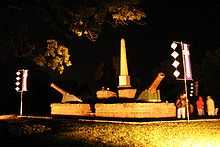Eureka, Victoria
| Eureka Ballarat, Victoria | |||||||||||||
|---|---|---|---|---|---|---|---|---|---|---|---|---|---|
 The Eureka Centre in 2009 prior to its redevelopment as the Museum of Australian Democracy at Eureka | |||||||||||||
 Eureka | |||||||||||||
| Coordinates | 37°33′53″S 143°52′56″E / 37.5648°S 143.8822°ECoordinates: 37°33′53″S 143°52′56″E / 37.5648°S 143.8822°E | ||||||||||||
| Population | 609 (2006)[1] | ||||||||||||
| • Density | 1,384/km2 (3,580/sq mi) | ||||||||||||
| Postcode(s) | 3350 | ||||||||||||
| Area | 0.44 km2 (0.2 sq mi) | ||||||||||||
| Location | 1.5 km (1 mi) from Ballarat Central | ||||||||||||
| LGA(s) | City of Ballarat | ||||||||||||
| State electorate(s) | Ballarat East | ||||||||||||
| Federal Division(s) | Ballarat | ||||||||||||
| |||||||||||||
Eureka is a small eastern suburb of Ballarat, Victoria, Australia. At the 2006 census, Eureka had a population of 609.[1]
Eureka is bordered by Specimen Creek to the north, Canadian Creek to the south, Queen and Joseph streets to the west and Kline and Stawell Street to the east. It is a small section of land within the larger suburb of Ballarat East.
The suburb takes its name from the Eureka Lead the gold mining lead of the Eureka Mining Company and is most notable as the site of the historic event of the Eureka Rebellion and the flag flown by the rebels known as the Eureka Flag both of which have national significance to Australia. The site is marked by several monuments including the Museum of Australian Democracy at Eureka (M.A.D.E), which opened in May 2013 and houses the symbolic Eureka Flag, on loan from the Art Gallery of Ballarat.
History

Civil disobedience in Eureka led to Australia's first and only armed civil uprising, the Eureka Rebellion (colloquially referred to as the Eureka Stockade) which took place on 3 December 1854. The event, in which 22 miners died, is considered to be a defining moment in Australian history.
For many years, Eureka was simply a locality in Ballarat East, however in 1946 it was officially gazetted as a suburb in its own right.
Transport
Eureka does not have a main commercial area and is almost entirely residential. The Buninyong railway line bisects the suburb, however the line is disused and the station has been closed for nearly a century.
Eureka Stockade Memorials

The Stockade gardens were set aside in 1864 to commemorate the Eureka Stockade event. The Eureka Stockade Monument was built in 1884 on a site selected by community vote.[2] The monument itself is an obelisk on a plinth flanked by four cannons.
A Eureka Trail was devised which follows the movement of the soldiers from the barracks at Camp Street, Ballarat, across Black Hill to the battle site at Eureka.
A purpose built interpretation centre for the Eureka Rebellion site was erected in 1998 near the site of the stockade. Designed to be a new landmark for Ballarat, the building featured an enormous sail emblazoned with the Eureka Flag.[3] Before its development there was considerable debate over whether a replica or reconstruction of wooden stockade structures was appropriate, however it was eventually decided against and this is seen by many as a reason for the apparent failure of the centre to draw significant tourist numbers.
By 2006 falling visitor numbers had led to a business case being commissioned, and a re-imagining of the centre.
Grants from the City of Ballarat and the Victorian and Federal Governments have enabled now the redevelopment of the site and the establishment of the new Museum of Australian Democracy at Eureka (M.A.D.E).
References
- ↑ 1.0 1.1 Australian Bureau of Statistics (25 October 2007). "Eureka (State Suburb)". 2006 Census QuickStats. Retrieved 2009-06-24.
- ↑ http://www.eurekaballarat.com/eureka/eureka-precinct/eureka-stockade-gardens.aspx
- ↑ http://www.eurekaballarat.com/
| |||||